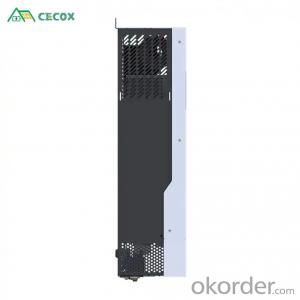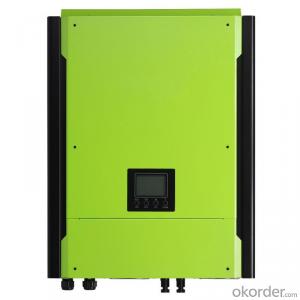Solar Inverter Battery Charger - 5.5kW Off-Grid Hybrid Solar Home Inverter with MPPT Charge Controller
- Loading Port:
- China main port
- Payment Terms:
- TT OR LC
- Min Order Qty:
- 1 unit
- Supply Capability:
- 10000 unit/month
OKorder Service Pledge
OKorder Financial Service
You Might Also Like
Specification
Advantages
110A PV MPPT input
Wide PV input voltage range
Overload/overtemperature/short circuit protection
Smart battery charger design to optimize battery performance
Support mains/generator input
Adaptive lithium battery
Support maximum parallel machine (P model)
Multiple charging voltages, suitable for different batteries
Multiple working modes: mains priority, PV priority
Key Parameters
Output Type:Single, Pure Sine Wave
Type:DC/AC Inverters
Inverter Efficiency:94%
Place of Origin:China
Model Number:XN5548, XN5548-P
Input Voltage:48V DC
Output Voltage:230V AC ± 5%
Output Current:23A
Output Frequency:50Hz/60Hz
Size:472W*297H*133D mm
Certificate:CE/IEC/ISO/TUV
Warranty:5 years
Weight:10.5kg
5.5KW Off-grid Hybrid Solar Home Inverter WithMPPT Charge Controller
Battery Type:Lithium/Lead-acid
Rated Power:5500W
Waveform:Pure Sine Wave
Transfer Time:10ms
Maximum PV Array Power:6000W
Maximum Solar Charge Current:110A
AC Input Voltage:230V AC
Communication Port:RS232 / RS485
Packaging and delivery
Package Type:Standard Export Package
Supply Ability:10000 Unit/Units per Month
Lead Time
Quantity (units) 1 - 100 101 - 500 501 - 1000 > 1000
Lead time (days) 7 14 21 To be negotiated
Customized packaging:(Min. order) 50000sets
- Q: Can a solar inverter be used with a solar-powered street lighting system?
- Yes, a solar inverter can be used with a solar-powered street lighting system. A solar inverter is responsible for converting the DC power generated by solar panels into AC power, which is necessary for powering street lights. By integrating a solar inverter, the solar-powered street lighting system can efficiently convert and utilize the energy generated by the solar panels, ensuring the proper functioning of the lights.
- Q: What is the efficiency of a solar inverter?
- The efficiency of a solar inverter refers to the percentage of solar energy that is converted into usable electricity. It is an important factor as higher efficiency means more energy is produced, reducing the overall energy loss. The efficiency of a typical solar inverter ranges from 95% to 98%, with some advanced models even surpassing 99%.
- Q: How does a solar inverter handle grid voltage variations?
- A solar inverter handles grid voltage variations by constantly monitoring the grid voltage and adjusting its output accordingly. It uses complex algorithms to regulate the voltage and frequency of the electricity it feeds into the grid, ensuring it matches the varying grid voltage. This allows the solar inverter to maintain a stable and consistent power output, regardless of any fluctuations in the grid voltage.
- Q: What is the difference between an on-grid and off-grid solar inverter?
- The main difference between an on-grid and off-grid solar inverter lies in their functionality and purpose. An on-grid solar inverter is designed to convert the direct current (DC) electricity generated by solar panels into alternating current (AC) electricity that can be fed into the electrical grid. This type of inverter is used in grid-tied solar systems, where excess energy can be sold back to the utility company, allowing homeowners to benefit financially. On the other hand, an off-grid solar inverter is used in standalone solar systems that are not connected to the electrical grid. It is responsible for converting the DC electricity produced by solar panels into AC electricity suitable for powering off-grid appliances and storing energy in batteries. Off-grid inverters often include additional features like battery charging and management to ensure reliable power supply in the absence of grid connection. In summary, while both on-grid and off-grid solar inverters convert DC to AC electricity, their purposes differ significantly. On-grid inverters enable homeowners to utilize the grid as a power storage and distribution system, while off-grid inverters are essential for self-sustaining solar systems that operate independently of the grid.
- Q: How long does it take to install a solar inverter?
- The time it takes to install a solar inverter can vary depending on various factors such as the complexity of the installation, the size of the system, and the experience of the installer. On average, it typically takes a few hours to a full day to complete the installation process.
- Q: Can a solar inverter work during a power outage?
- No, a solar inverter cannot work during a power outage.
- Q: What is the maximum number of solar panels that a solar inverter can support?
- The maximum number of solar panels that a solar inverter can support depends on the specific model and capacity of the inverter. Different inverters have different power ratings and input capacities, which determine the number of solar panels they can handle. It is important to consult the manufacturer's specifications or consult with a professional to determine the appropriate number of panels that can be supported by a particular solar inverter.
- Q: What is the role of a fault detection feature in a solar inverter?
- The solar inverter relies on a fault detection feature to oversee and detect any irregularities or malfunctions within the system. This crucial feature is essential for the smooth and efficient functioning of the solar inverter. Constantly monitoring the solar inverter's various components and parameters, such as input and output voltages, current levels, temperature, and other critical factors, the fault detection feature analyzes real-time data and compares it to predetermined thresholds or expected values. If any parameter strays from the normal range or exceeds set limits, the fault detection feature promptly identifies it as a fault or abnormality. The primary objective of this feature is to safeguard the solar inverter from potential harm and prevent any safety risks. By swiftly detecting faults, the inverter can take appropriate actions to address the issue or shut down the system if necessary. This safeguards the inverter and other connected devices from further damage. Additionally, the fault detection feature aids in troubleshooting and determining the root cause of the fault. It offers valuable information about the fault's type and location, enabling faster and more accurate repairs or maintenance. This reduces downtime and ensures optimal performance and longevity of the solar inverter. Furthermore, the fault detection feature plays a vital role in system monitoring and maintenance. It provides valuable data and notifications to system operators or maintenance personnel, allowing them to proactively address any potential issues. This maximizes the uptime of the solar inverter and minimizes overall maintenance costs. To summarize, the fault detection feature in a solar inverter continuously monitors, identifies, and responds to faults or abnormalities in the system. Acting as a protective mechanism, it ensures the safe and reliable operation of the inverter, enables swift troubleshooting, and facilitates efficient maintenance practices.
- Q: Are there any government incentives or rebates available for solar inverters?
- Yes, there are various government incentives and rebates available for solar inverters. These incentives vary from country to country and even within different regions. They can include tax credits, grants, and rebates offered by federal, state, or local governments. It is recommended to check with relevant government agencies or consult with a solar installer to determine the specific incentives available in the desired location.
- Q: Can a solar inverter be used with a wind turbine?
- Certainly! It is indeed possible to utilize a solar inverter alongside a wind turbine. Both wind turbines and solar panels generate direct current (DC) electricity, which necessitates conversion to alternating current (AC) in order to power the majority of household appliances and connect to the electrical grid. The primary function of a solar inverter is to convert DC electricity produced by solar panels into AC electricity. Interestingly, it can also perform the task of converting DC electricity generated by a wind turbine into AC electricity. However, it is worth mentioning that wind turbines typically produce higher voltage and fluctuating currents in comparison to solar panels. As a result, the inverter employed with a wind turbine may require specific design considerations to effectively manage these variations. Additionally, it is common for wind turbines to possess their own specialized inverters that are meticulously optimized to suit their unique electrical characteristics.
Send your message to us
Solar Inverter Battery Charger - 5.5kW Off-Grid Hybrid Solar Home Inverter with MPPT Charge Controller
- Loading Port:
- China main port
- Payment Terms:
- TT OR LC
- Min Order Qty:
- 1 unit
- Supply Capability:
- 10000 unit/month
OKorder Service Pledge
OKorder Financial Service
Similar products
Hot products
Hot Searches
Related keywords


































